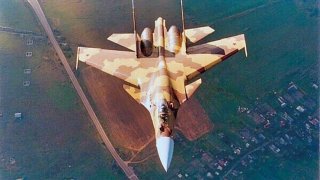Russia's Su-37 Fighter was a Flying 'Terminator'
The Russian Su-37 "Flying Terminator" was a demonstrator aircraft that showcased several cutting-edge technologies despite its ultimate failure.
Summary: The Russian Su-37 "Flying Terminator" was a demonstrator aircraft that showcased several cutting-edge technologies despite its ultimate failure. Developed by the Sukhoi Design Bureau, the Su-37 featured advanced thrust-vectoring nozzles, next-generation radar capable of tracking 20 targets, and a sophisticated avionics package displayed across four LCD screens.
-Its superior maneuverability and "no angle-of-attack limitations" highlighted its potential as an agile dogfighter.
-However, a critical software glitch led to its crash in 2002, ending its development. Despite this, the Su-37 played a crucial role in informing the design and technology of subsequent Sukhoi aircraft, marking it as one of Russia’s most significant demonstrators.
The Rise and Fall of the Su-37 'Flying Terminator': A Technological Marvel with a Tragic End
Russia’s Su-37 “Flying Terminator” appears to be a disaster. But it was not as much of a burning mess as it seemed to be. Created as a demonstrator plane by the Sukhoi Design Bureau, one of the most storied Russian warplane designers, the Su-37 had several cutting-edge technological features that made it a unique bird for its time.
Despite these innovative technologies, the demonstrator plane was a failure. After all, the Su-37 crashed in 2002 following a critical software glitch.
Su-37 Specs
Still, it’s important to understand just what kind of technologies the Su-37 was demonstrating for the Russian military. The Su-37 had experimental, Lyulka-Saturn AL-31FP thrust-vectoring nozzles. The Su-37 had next-generation radar (N011MBars), which could track up to 20 different targets at a time. The plane possessed a highly advanced avionics package (for its time). The telemetry coming from these advanced systems appeared on four LCD screens in the cockpit (a cutting-edge technology at the time of the Su-37’s creation).
These advanced features to the plane being a remarkably maneuverable bird, enhancing its overall combat capabilities. In fact, the Su-37 had a world-class fly-by-wire system and its proponents claimed that the bird had “no angle-of-attack limitations.” As Peter Suciu observed, “this would have made [the Su-37] an agile dogfighter.”
The downsides to this plane were that it was not user friendly, meaning that only the best trained pilots could fly these birds, decreasing the potential combat effectiveness of this model. Ironically, the very features that made the Su-37 such a radical and brilliant new warbird were what undermined its operational integrity.
Some Important Facts
This bird had a whopping 12 external hardpoints with a maximum weight of 8,000 kilograms. Like many other modern warplanes, the Su-37 could carry a mixed ordnance package, consisting of R-73E short-range missiles and R-77 missiles. The Su-37 could carry radar-homing missiles, making it a ground-attack warplane as well as a fierce dogfighter. There was also a single GSh-301 30-mm cannon with 150 rounds onboard.
Throughout the 1990s, the Su-37 demonstrator plane traveled the world, displaying its amazing, next-generation systems—and cutting-edge maneuverability—to audiences at various airshows, garnering a grand reputation for itself. Sadly, all that came crashing down to Earth in 2002. The bird suffered a catastrophic software glitch. The Su-37 lost its horizontal stabilizer as it fell to the Earth.
Su-37: A Great Plane
After the crash, the Sukhoi Design Bureau decided against building anymore Su-37 warplanes. Yet, the data that had been collected over the decade of the demonstrator’s existence led the Sukhoi engineers to integratecritical lessons learned along with the advanced technologies into other warbirds the company was building. In fact, most of the modern Sukhoi jets flying today—or even those under development—would not exist today without the hard lessons learned from the Su-37.
So, far from being a failed byproduct of the tumultuous post-Soviet Russian 1990s scene, the Su-37 should go down as one of the best demonstrators ever conceived. It might even be the best demonstrator plane in the aviation history of Russia.
This plane contributed to multiple innovations in the next-generation or Russian warplane design that has enhanced Russia’s airpower. Whatever one’s opinion of the Russians following their illegal invasion of Ukraine in 2022, the Su-37 was a modern marvel.
About the Author
Brandon J. Weichert, a National Interest national security analyst, is a former Congressional staffer and geopolitical analyst who is a contributor at The Washington Times, the Asia Times, and The-Pipeline. He is the author of Winning Space: How America Remains a Superpower, Biohacked: China’s Race to Control Life, and The Shadow War: Iran’s Quest for Supremacy. His next book, A Disaster of Our Own Making: How the West Lost Ukraine, is due October 22 from Encounter Books. Weichert can be followed via Twitter @WeTheBrandon.


